Apr 24, 2024
Apr 24, 2024
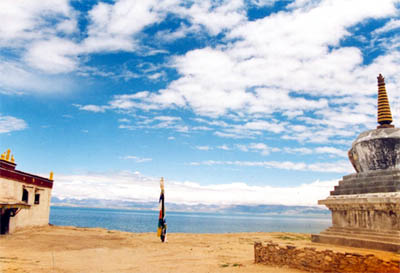 I had, in response to a newspaper ad from the Ministry of External Affairs (MEA), put in an application for Kailash Manasarovar Yatra 2003 and after a series of exhaustive and exhausting medical tests at New Delhi and Gunji, been lucky enough to be finally selected. A bus-ride from New Delhi to Mangti via Almora and a trek through the scenic district of Pithoragarh later, I had crossed to Tibet over the Lipulekh Pass in company of thirty-seven yatris, including a Liaison Officer deputed by the MEA.
I had, in response to a newspaper ad from the Ministry of External Affairs (MEA), put in an application for Kailash Manasarovar Yatra 2003 and after a series of exhaustive and exhausting medical tests at New Delhi and Gunji, been lucky enough to be finally selected. A bus-ride from New Delhi to Mangti via Almora and a trek through the scenic district of Pithoragarh later, I had crossed to Tibet over the Lipulekh Pass in company of thirty-seven yatris, including a Liaison Officer deputed by the MEA.
The two-day halt at Taklakote, the erstwhile trading town of Purang, was for immigration, orientation, foreign currency exchange, shopping for provisions, etc. At Taklakote we were divided into two groups, 'Shiv' group to visit Kailash first and the other, 'Shakti', Manasarovar. There were twelve ladies among the 37 yatris & were divided six per group. I was in the Shakti group scheduled to visit Manasarovar first. The following is an account of our experiences during the parikrama.
Manasarovar Parikrama
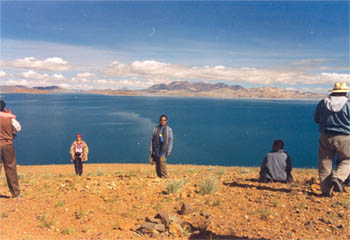 The bus from Taklakote to Qihu (pronounced Cheehoo) passes through deserted countryside devoid of trees and shrubs. The stony ground is covered with low cushions of vivid wild flowers near streams. In that high altitude plants lose their height. Streams are very common in July with the snow melting in the higher reaches. The driver hits every stream with the confidence of a seasoned man without even slowing down. Bridges do not exist. Debris of ancient monasteries still remains. The carved stones inscribed with Tibetan script are festooned with Buddhist prayer flags. Each time the bus passes the stone piles, the Tibetan 'Helper' recruited at Taklakote shouts something like 'Shash'shaa', whatever that means. The Chinese driver completely ignores him.
The bus from Taklakote to Qihu (pronounced Cheehoo) passes through deserted countryside devoid of trees and shrubs. The stony ground is covered with low cushions of vivid wild flowers near streams. In that high altitude plants lose their height. Streams are very common in July with the snow melting in the higher reaches. The driver hits every stream with the confidence of a seasoned man without even slowing down. Bridges do not exist. Debris of ancient monasteries still remains. The carved stones inscribed with Tibetan script are festooned with Buddhist prayer flags. Each time the bus passes the stone piles, the Tibetan 'Helper' recruited at Taklakote shouts something like 'Shash'shaa', whatever that means. The Chinese driver completely ignores him.
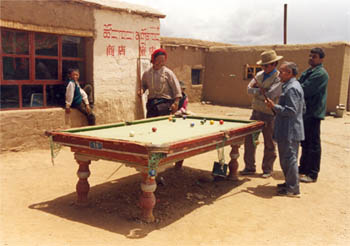 Hore (pronounced Ho-ray) is a hamlet on the way. We stop to stock up on vegetables and end up buying three radishes for twenty yuan, that is Rs 120! General heart attacks occur all round from the price of veggies. We come across a surprisingly delicious canned variety of litchi juice for four yuans. The eldest yatri, a sprightly 69 year old, also discovers the popular local past time of playing snooker and is cordially invited for a round by the Tibetans. The resultant game has both sides passing comments, which the opposite side does not understand, perhaps luckily.
Hore (pronounced Ho-ray) is a hamlet on the way. We stop to stock up on vegetables and end up buying three radishes for twenty yuan, that is Rs 120! General heart attacks occur all round from the price of veggies. We come across a surprisingly delicious canned variety of litchi juice for four yuans. The eldest yatri, a sprightly 69 year old, also discovers the popular local past time of playing snooker and is cordially invited for a round by the Tibetans. The resultant game has both sides passing comments, which the opposite side does not understand, perhaps luckily.
We pass Rakshas Tal on the way. It is an impossibly blue lake with still waters. We see no birds there. Legend goes that King Ravana attained the boon of immortality from Lord Shiva after meditating on the banks of this lake. The Rakshas Tal or Ravana Tal, is connected to the Manasarovar by Ganga 'chu, a channel which also we do not see. First view of Kailash unexpectedly hits us round a bend in the road. The snowy peak stands aloof behind snow-free ranges. Cameras go berserk.
Qihu has a hilltop monastery left untouched by the revolution. At the foot of the hillock is a hotel, basically a single row of rooms (financed by NRIs) opening out into a courtyard. The yard also hosts tents into which the occupants of the rooms are moved out on our arrival. The people thus unceremoniously ousted, turn out to be the Indian tourists visiting Tibet through Nepal being hauled around custom made trips in Toyota Land cruisers with back up trucks. The Kailash is visible from Qihu and resembles more a lump of vanilla ice cream on an empty stone horizon. The southern face of the mountain has the distinctive horizontal & vertical markings like a ladder ascending to the heavens. There are hot sulphur spring baths available @ twenty yuan per head at Qihu. There is also the Manasarovar Lake.
The Manasarovar Lake is huge with a circumference of about 88 km and changes color with the sun. Flocks of birds (gulls and different kinds of ducks) populate the shores. The water is crystal clear and shoals of fish are visible among the colorful stones glimmering on the lakebed. Qihu has a silty beach cushioned with aquatic weeds. There are also quick-sands in places and a wire fence marks off safe limits in the waters.
The Shiv group sets off for Kailash parikrama leaving us, the Shakti group, behind at Qihu. The cooking stoves supplied throughout the trip resemble welding machines with a foot-long lateral flame jetting out. Only the Tibetan helper, Karma, can put it on, though with practice we learn to switch it off. One digs a hole about a foot deep in the ground, puts the stove on and places the stove side ways in the hole so that the lateral flame now points vertically up for cooking! The pressure cooker is then put on a tripod. One lives to learn.
The kitchen is a tent at Qihu and an out-house in some other places and we are the cooks. Karma is the helper @75 yuans per day to bring water and for washing up utensils. With nil English/Hindi vocabulary Karma blossoms into an asset later as a guide and general factotum when the actual guide Guru is being uncooperative. It is more a picnic than a pilgrimage at times with all of us taking turns with the cooking. A particularly unflappable Maratha is put in charge of the kitchen and who, while listening patiently to everyone, does precisely what he wants. A detailed menu chart is drawn up for each day meal-wise. An agency in New Delhi had supplied us with dry provisions. This is supplemented with our purchases and whatever had been carried over by individual yatris from India. Apart from atta we have chura, dal, papad, ready-to-cook items (foil packed mattar paneer, upma, sambar rice, tins of chatpatta chana, dal makhani, etc), soup mixes, instant coffee, pickles. The sack of rice has vanished somehow and there is no tin opener. There is also no belun /chakla/ tawa for using the atta.
Since it is a sunny day all of us decide on a holy dip in the lake. Honestly speaking the temperature of the water is quite tolerable in the sun, except for the blasting wind. The wind chill factor bites into our wet skin as we stand in knee-deep water trying to remember our ancestors, family and friends, offer water and take quick dips. We scare away the fish and stir up silt. Contrary to popular expectations, there are no lotuses in Manasarovar and I at least do not see a proper swan. There are golden brahminy ducks honking away, which the faithful interpret as chanting of 'OM'.
Next day another bus comes to take us to Qugu (Q-goo). Qugu also has a monastery under 'Trus Gho Monastery Democratic Management Committee' and we stay in the attached barracks. The beach at Qugu is stony without a trace of silt and we really enjoy ourselves bathing inspite of the wind. The two days' halt at Qugu is spent relaxing. The lama from the monastery lends his roti equipment and we utilize the atta. Several kilos are added to the luggage with jerry cans of holy water and stones from the lake. Incidentally we drink the lake water for four days of the Manasarovar parikrama without boiling and without falling sick. A 'Hom'/yagna is performed by the group at Qugu as per our limited knowledge and the dry fruit is fruitfully used up as prasad. The sun decides to grace with its presence and there is surprisingly no high wind. Kailash is visible from across the lake at Qugu and we see the flanks covered with clouds. The lama predicts snow & rain for Shiv group undertaking its parikrama there. Meanwhile we enjoy spectacular sun-sets on the lake.
The lama turns out to be quite a business man with a quaint shop selling cans of juices (fruit, both fresh & fermented), different chinese ready-to-eat food which no yatri dares experiment with, trinkets, shoes, caps, torches, etc. There are, also, interestingly enough, money checker torchlights for sale @ five yuans each, with which one checks counterfeit currency! The shop does brisk business. We return to Qihu to complete the Manasarovar parikrama.
Trekking around Kailash
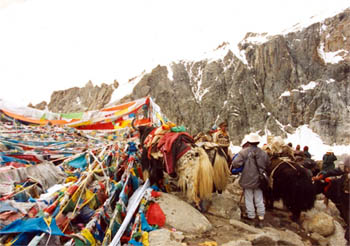 Kailash Parikrama starts from Darchen and takes three days. The road / path is not motorable and one does it on foot and / or yak. As per the MEA handout Darchen has ISD facilities. We are unable to trace any and are bitterly disappointed. We have reached on a Sunday after the Manasarovar parikrama (no phones for four days) and had hoped for calls home. Darchen is a mix of Tibetan settlements with a hospital of Tibetan medicine, make-shift shops selling curios and rooms rented to tourists for stay. There is also a Chinese guesthouse for the Common People. Tibetan ladies dressed in their traditional finery visit the tourist rooms laden with goods for sale. Bargaining is as much a past time as snooker in Tibet. First bid of 200 yuans may well go for a final sale at 30 yuans, as happened with a dagger etched with Chinese lions in my case.
Kailash Parikrama starts from Darchen and takes three days. The road / path is not motorable and one does it on foot and / or yak. As per the MEA handout Darchen has ISD facilities. We are unable to trace any and are bitterly disappointed. We have reached on a Sunday after the Manasarovar parikrama (no phones for four days) and had hoped for calls home. Darchen is a mix of Tibetan settlements with a hospital of Tibetan medicine, make-shift shops selling curios and rooms rented to tourists for stay. There is also a Chinese guesthouse for the Common People. Tibetan ladies dressed in their traditional finery visit the tourist rooms laden with goods for sale. Bargaining is as much a past time as snooker in Tibet. First bid of 200 yuans may well go for a final sale at 30 yuans, as happened with a dagger etched with Chinese lions in my case.
For the local Buddhists 'Kora' is the Kailash parikrama done by the devout prostrating himself on the road with out stretched arms, getting-up, walking the few feet to where his hands had touched the ground, doing namaskar to the Gods and lying down to again prostrate himself and repeat the arduous process till he does a complete round of the 54 km parikrama path. He wears slippers or thick gloves on his hands to protect them while doing this penance to absolve of past sins. We actually later pass several people doing it this way, which was quite amazing in the inhospitable climate of Tibet.
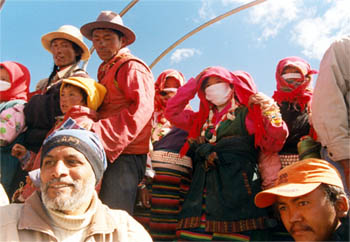 The 32 km trip from Qihu to Darchen is by bus. We are to go from Darchen to Deraphuk, a distance of twenty km of which about ten to Yamduar (literally Gateway of the God of Death) is motorable. Porters and yaks are booked on individual demand of the yatris and are scheduled to meet us at Yamduar.
The 32 km trip from Qihu to Darchen is by bus. We are to go from Darchen to Deraphuk, a distance of twenty km of which about ten to Yamduar (literally Gateway of the God of Death) is motorable. Porters and yaks are booked on individual demand of the yatris and are scheduled to meet us at Yamduar.
We load on to a truck. There are no seats in the truck and no steps to get up. We learn to climb onto the wheels and over the side since the back of the truck is shut and not let down for us. The truck ride is an Experience with us yelling like school kids on an outing each time the wheels hit a pothole. The journey takes three hours of bone rattling till we reach the Valley of the Gods.
For those who have seen Mackenna's Gold, the movie might have well been shot in that valley. Deviation only lay in the waterfalls foaming down the sheer cliffs and torrents rushing through the valley. The Kailash mountain glaciers give rise to four major rivers, Indus, Sutlej, Brahmaputra and Karnali. The streams are joined by innumerable tributaries that turn the ground marshy at places, dotted with clumps of wild flowers. In the following days whenever I got my feet wet wading through the icy flows, I refrained from cursing remembering that the same waters are ultimately flowing through some part of India as the mighty rivers.
The Tibetan porters and yak men are found waiting with their yaks and dogs. A lottery is conducted to allot porters and yaks to the yatris. This is to rule out any chance of favoritism in choice of yaks. In other words if you come a cropper on your yak, you have no one to blame except your luck in the lottery. Having earlier seen only the docile decorated yaks paraded around the Chhangu Lake in Sikkim, my perception of yaks totally changed during this visit. A more viciously unpredictable animal will be hard to find. It moves as per its mood, rushing with surprising speed (for its massive bulk) up a sheer cliff or down a steep slope carrying its hapless and helpless rider screaming unheeded. There is no bridle and no stirrup to hold on and climb up. The yak man dumps you like a sack of potatoes onto the yak. There is no proper saddle either, only a folded blanket to sit on. The back of the yak is too wide for a person of normal height to straddle, so your legs stick out to be smashed against passing rocks if you are not nimble enough to do gymnastics on yak-back. The yak has a one-track mind formatted to read 'Breakfast'.
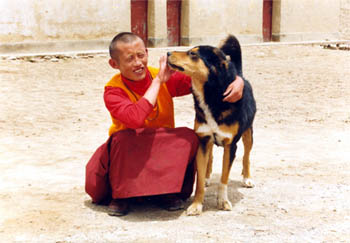 The wild flowers, whose beauty had us waxing eloquent, are rudely trampled and chomped. Without a warning grunt any given yak butts its horns into any other yak at any give point of time, often leading to the latter shedding its rider like an autumn leaf. There is a wooden structure about a foot wide, which serves as a handle for the rider to cling onto to avoid being thrown. The rider gets too terrified sometimes and the fingers simply unclench their grip on the wooden handle. A number of yatris were thrown, but fortunately none suffered more than bruises. I was one of the lucky few who never fell off but had to endure near heart attacks from the antics of my yak and bruised thighs from other yaks' horns. The yak men do not lead the yaks by the reins, normally communicating with them in a series of sharp whistles. Even the children of the locals learn to whistle early and well. Huge Tibetan mastiffs sprint along acting as night guards at halts. The yaks and the dogs sometimes have running feuds (involving nipped ankles and buttings) to the detriment of the riders. I can personally vouch for the fact that it sometimes takes four adults to control a yak enough even to put the blanket on its back. It is said that a yak becomes docile only when a ring of juniper wood is driven through its nose and it is lead by it. This may or may not account for the docility of the Sikkimese yaks, I do not know. For all the evils yaks are invaluable to cross the Dolma-la, which at a height of more than 19,000 feet, has too rarified an air for us plains-people to breath without panting and gasping.
The wild flowers, whose beauty had us waxing eloquent, are rudely trampled and chomped. Without a warning grunt any given yak butts its horns into any other yak at any give point of time, often leading to the latter shedding its rider like an autumn leaf. There is a wooden structure about a foot wide, which serves as a handle for the rider to cling onto to avoid being thrown. The rider gets too terrified sometimes and the fingers simply unclench their grip on the wooden handle. A number of yatris were thrown, but fortunately none suffered more than bruises. I was one of the lucky few who never fell off but had to endure near heart attacks from the antics of my yak and bruised thighs from other yaks' horns. The yak men do not lead the yaks by the reins, normally communicating with them in a series of sharp whistles. Even the children of the locals learn to whistle early and well. Huge Tibetan mastiffs sprint along acting as night guards at halts. The yaks and the dogs sometimes have running feuds (involving nipped ankles and buttings) to the detriment of the riders. I can personally vouch for the fact that it sometimes takes four adults to control a yak enough even to put the blanket on its back. It is said that a yak becomes docile only when a ring of juniper wood is driven through its nose and it is lead by it. This may or may not account for the docility of the Sikkimese yaks, I do not know. For all the evils yaks are invaluable to cross the Dolma-la, which at a height of more than 19,000 feet, has too rarified an air for us plains-people to breath without panting and gasping.
Deraphuk has a single barrack-like building with rooms for the yatris to share. Who-so-ever stays there may be prepared to suffer strangers walking into the rooms and staring. This is a perpetual problem compounded by the fact that the rooms allotted to us ladies never seem to have a lock throughout the tenure in Tibet.
I reach Deraphuk around 5 pm after a four-hour yak ride. Any reasonably fit person can easily do the ten km stretch from Yamduar to Deraphuk on foot, but I decide to practice riding on the yak in preparation for crossing of the Dolma pass the next day. This turns out to be very sensible and perhaps contributes to my fall-less tour.
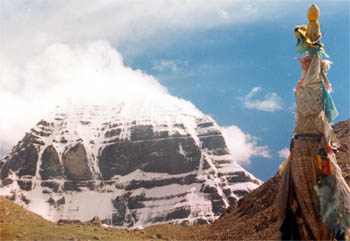 The view of the northern face of Kailash is spectacular from Deraphuk and gives its closest view. The mountain is said to have four faces like jewels as per Tibetan mythology (North- Gold, South- Lapis lazuli, East- Crystal and West- Ruby) and is also associated with four animals. After dumping our things in the room some of us decide to go nearer the mountain. The mountain proper is held sacred and as per an international treaty nobody is allowed to climb it. The closeness turns out to be an illusion as we cross three hillocks only to find more ahead. We nearly reach a glacier giving rise to a river. The place is the most eerily beautiful one I have been ever in. There is a peculiar aura that probably exists in my imagination, I do not know. You can sit there for hours. This face of Kailash is too vertical to even hold snow (unlike the southern face forever blanketed in white) except in the thin ridges. The stone appears glossy black and totally different from that of the surrounding mountains, which have brown, flaky layered sedimentary rocks crumbling from sun and snow. The lowering clouds suddenly burst into a shower of hail and we are forced to turn back willy-nilly.
The view of the northern face of Kailash is spectacular from Deraphuk and gives its closest view. The mountain is said to have four faces like jewels as per Tibetan mythology (North- Gold, South- Lapis lazuli, East- Crystal and West- Ruby) and is also associated with four animals. After dumping our things in the room some of us decide to go nearer the mountain. The mountain proper is held sacred and as per an international treaty nobody is allowed to climb it. The closeness turns out to be an illusion as we cross three hillocks only to find more ahead. We nearly reach a glacier giving rise to a river. The place is the most eerily beautiful one I have been ever in. There is a peculiar aura that probably exists in my imagination, I do not know. You can sit there for hours. This face of Kailash is too vertical to even hold snow (unlike the southern face forever blanketed in white) except in the thin ridges. The stone appears glossy black and totally different from that of the surrounding mountains, which have brown, flaky layered sedimentary rocks crumbling from sun and snow. The lowering clouds suddenly burst into a shower of hail and we are forced to turn back willy-nilly.
09-Oct-2005
More by : Kana Talukder

|
sir ji agar yahi kahani aap hindi me likhete to hum jaise log bhi pad sakte |